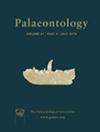树懒颅脑和颅脑后特征的形态学差异和进化速率(哺乳纲,毛门目,叶门目)
IF 2.3
2区 地球科学
Q1 PALEONTOLOGY
引用次数: 2
摘要
树懒的形态进化已经被广泛地定性研究,通过比较解剖学和形态功能方法,或通过使用形态计量学对形态变异进行定量评估。然而,直到最近才开始使用离散特征数据来评估folivoran的形态差异和进化率。尽管如此,在不同的特征分区中形态进化的模式还没有被研究过,也没有研究树懒的相对影响,一方面是系统发育,另一方面是饮食和运动适应。在这里,我们使用层形态空间方法来评估这些模式,量化形态差异和进化速度,并研究Folivora颅和颅后特征形态进化的可能驱动因素。尽管这两个分区在整体进化速度上并没有本质上的差异,但这些分区的形态演变与进化支系和生态群体之间明显的差异模式有关。历史过程比生态过程更一致地塑造了树懒的形态进化,尽管颅后特征的变化似乎也与运动适应有关,在运动适应中形态趋同更为常见。我们还讨论了在研究主要由化石分类群组成的分区数据集时重要的方法权衡。本文章由计算机程序翻译,如有差异,请以英文原文为准。
Morphological disparity and evolutionary rates of cranial and postcranial characters in sloths (Mammalia, Pilosa, Folivora)
Sloth morphological evolution has been widely studied qualitatively, with comparative anatomy and morpho‐functional approaches, or through quantitative assessments of morphological variation using morphometrics. Only recently, however, have folivoran morphological disparity and evolutionary rates begun to be evaluated using discrete character data. Nonetheless, patterns of morphological evolution in separate character partitions have not been investigated, neither the relative influence of, on the one hand, phylogeny, and on the other, dietary and locomotory adaptations of sloths. Here we evaluate those patterns using a phylomorphospace approach, quantifying morphological disparity and evolutionary rates, and investigating possible drivers of morphological evolution for cranial and postcranial characters in Folivora. The evolution of the morphology in those partitions is associated with distinct patterns of disparity among clades and ecological groups, even though the two partitions do not differ substantially in overall evolutionary tempo. Historical processes shaped the morphological evolution of sloths more consistently than ecological ones, although changes in postcranial characters also seem to be associated with locomotory adaptations, in which morphological convergences were much more common. We also discuss important methodological trade‐offs in investigations of partitioned datasets mostly composed of fossil taxa.
求助全文
通过发布文献求助,成功后即可免费获取论文全文。
去求助
来源期刊

Palaeontology
地学-古生物学
CiteScore
5.60
自引率
3.80%
发文量
43
审稿时长
6 months
期刊介绍:
Palaeontology publishes a wide variety of papers on palaeontological topics covering:
palaeozoology
palaeobotany
systematic studies
palaeoecology
micropalaeontology
palaeobiogeography
functional morphology
stratigraphy
taxonomy
taphonomy
palaeoenvironmental reconstruction
palaeoclimate analysis and biomineralization studies.
 求助内容:
求助内容: 应助结果提醒方式:
应助结果提醒方式:


